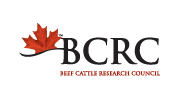Pasture management and productivity
| Project Code: | 2.68 |
| Completed: | October 2006 |
Project Title:
Carbon sequestration, methane production and nitrous oxide emissions from cattle grazing native prairie
Researchers:
Dr. Alan Iwaasa iwaasa@agr.gc.ca
Background Forage yields, stand life, and the productivity of grazing animals is largely determined by the weather and the forage varieties, fertilization and grazing management practices that a producer chooses to use.
Including a legume like alfalfa or sainfoin in a grass stand generally increases soil nitrogen, forage productivity, and animal gains. Some producers have been reluctant to include alfalfa in pasture mixes because of the increased risk of bloat. Sainfoin has a lower risk of bloat than alfalfa, but may also have lower forage yields and shorter stand life than alfalfa.
Grazing management also impacts soil quality. Overgrazed pastures develop a less extensive root system than appropriately grazed forages, but the timing and intensity of grazing is also important. Soil fertility, organic matter content and water holding capacity benefit when forages have a healthy root system.
Objectives
To assess changes in soil quality in native range that has been grazed continuously (season long) or in a short-duration rotational manner, and to evaluate cattle performance and forage productivity and persistence in alfalfa-grass and sainfoin pastures.
What they did
These researchers conducted two experiments near Swift Current, Saskatchewan. Experiment 1 involved a native mixed grass prairie pasture on sandy loam soil with rolling topography that had been used in a 14 year grazing trial. Hilltops were primarily crested wheatgrass, slopes contained needle and thread, blue grama, and Northern and Western wheat grasses, and low spots had snowberry and bromegrass. The pasture was sub-divided so that each paddock contained hilltops, slopes and depressions. Some paddocks were grazed continuously end of May through early July), and others were grazed in a deferred-rotational manner (turnout dates of mid-May, late-June, mid-August and late September). Pastures were grazed to a height of 3 to 5 cm. Soil moisture, nitrogen, and organic content was measured on hilltops, slopes and low spots at the end of the 14 year study.
In Experiment 2, pastures containing either sainfoin (Nova) or a mix of alfalfa (Spredor) and hybrid brome grass (AC Knowles) were established and grazed in July for three seasons. Steers were pulled after 60 to 65% of the forage had been consumed. Forage samples were collected and analyzed for crude protein and fiber content.
Forage yield, average daily gain, grazing days, and total live weight gain per acre were also recorded.
What they learned
Soil quality: In Experiment 1, soil organic matter levels were the same in both the continuously and rotationally grazed pastures. However, soil organic matter levels were higher in low spots than on hilltops. This probably reflects the fact that more moisture is available in the depressions, allowing more productive forage species to thrive and accumulate more organic matter in the soil. Differences in soil quality between the two grazing systems may have become evident if the trial was longer than 14 years
Experiment 2 evaluated legume persistence, forage yield, quality, and animal productivity in alfalfa-grass and sainfoin pastures over a four year period:
Forage yield was 20% higher for the alfalfa-grass pastures (12.6 tons/acre) than the sainfoin pastures (10.7 tons/acre).
Forage quality: the sainfoin samples had lower fiber (ADF and NDF) levels and higher digestibility than the alfalfa-grass samples, but the alfalfa-grass samples had higher protein levels than the sainfoin samples.
Legume persistence: Maintaining legume stands was a challenge in both pastures. Alfalfa and sainfoin plant counts both dropped by 50% over the four years of the grazing trial.
Animal performance: Average daily gain was the same for the sainfoin pasture as for the alfalfa-grass pasture. But cattle were grazed 82% longer on the alfalfa-grass pasture than on the sainfoin pastures (because of differences in forage production), so total live weight gain per acre was 77% higher on the alfalfa-grass pastures (699lb / acre) than on the sainfoin pastures (394 lb / acre).
What it means
Selection of genetically improved sainfoin varieties could produce a bloat safe legume that is more productive and better able to compete and persist in pastures. Legume persistence would also benefit from the development of grazing strategies that consider the critical growing periods of legume species. This would help to improve forage and soil quality, allow safer grazing of legume pastures, and improve animal performance.
Further research to develop genetically improved sainfoin varieties and modifed grazing strategies could contribute to more competitive and persistent legumes, improved forage and soil quality, safer grazing of legume pastures, and improved animal performance.







